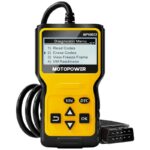The Obd2 Code U1000 indicates a critical issue within your vehicle’s communication system: “Lost Communication with CAN (Controller Area Network) Bus.” This network acts as the central nervous system of modern cars, enabling various electronic modules to communicate with each other. A disruption in this communication can lead to a range of problems, from minor inconveniences to major drivability issues. This article will delve into the intricacies of the U1000 code, outlining its symptoms, causes, diagnostic procedures, and potential solutions.
Understanding the CAN Bus and U1000
Your vehicle’s CAN bus is a sophisticated network connecting various modules, such as the engine control module (ECM), transmission control module (TCM), and body control module (BCM). These modules constantly exchange data to manage essential functions like engine performance, transmission shifting, braking, and even climate control. The U1000 code signifies a breakdown in this communication, preventing modules from sharing vital information. This code is often accompanied by other, more specific codes that pinpoint the affected module or circuit.
Symptoms of a U1000 Code
The symptoms of a U1000 code can vary widely depending on the specific module or circuit experiencing the communication breakdown. Some common indicators include:
- Illuminated Check Engine Light: This is the most common symptom, alerting you to a potential problem within the vehicle’s systems.
- Secondary Diagnostic Trouble Codes (DTCs): As mentioned earlier, U1000 is often associated with other codes that provide more specific information about the location of the fault.
- Performance Issues: These can range from a no-start condition to rough idling, poor fuel economy, and even transmission problems.
- Malfunctioning Systems: Depending on the affected module, you may experience issues with your vehicle’s HVAC system, lighting, power windows, or other electrical components.
Common Causes of a U1000 Code
Several factors can contribute to a U1000 code, including:
- Faulty Control Module: A malfunctioning module can disrupt communication on the CAN bus.
- Wiring Issues: Damaged, corroded, or loose wiring within the CAN bus network can interrupt signal transmission.
- Short Circuits: A short circuit in the wiring can also lead to communication failure.
- Low Battery Voltage: Insufficient voltage can prevent modules from communicating effectively.
- Faulty CAN Bus Terminator: Terminating resistors at each end of the CAN bus maintain signal integrity. A faulty resistor can disrupt communication.
Diagnosing and Repairing a U1000 Code
Diagnosing a U1000 code often requires specialized tools and expertise. Here are some common diagnostic procedures:
- Preliminary Inspection: Check for obvious signs of damage, loose connections, or corroded wiring.
- Scan for Codes: Use an OBD2 scanner to retrieve all stored codes, not just the U1000 code. This can provide valuable clues about the source of the problem.
- Check Technical Service Bulletins (TSBs): Consult manufacturer TSBs for known issues and recommended repair procedures.
- Module Roll Call: Using a professional scan tool, perform a module roll call to identify non-responsive modules.
- Network Testing: Use a digital multimeter (DMM) to check for continuity, shorts, and opens in the CAN bus wiring. Test terminating resistor resistance.
- Breakout Box Testing: A breakout box allows for in-depth analysis of CAN bus signals and communication.
Conclusion
The OBD2 code U1000 signifies a serious communication problem within your vehicle’s CAN bus network. While a simple loose connection might be the culprit, more complex issues like faulty modules or wiring damage are also possible. Given the complexity of the CAN bus system, diagnosing and repairing a U1000 code is best left to qualified automotive technicians with the necessary expertise and tools.

